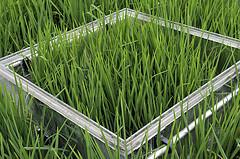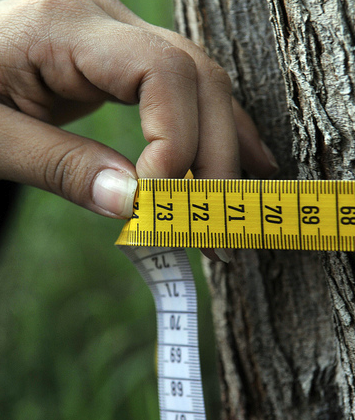Tackling climate change requires a better understanding of the options we have to reduce emissions from food and farming while providing food security. Agriculture is the source of roughly 10-12% of total annual GHG emissions and the cause of 75% of deforestation globally, with most of these emissions coming from developing countries. Yet agricultural yields must increase if we are to feed the projected 9 billion people on our planet in 2050. How can we ensure food security in the developing world while reducing the impact of food on the climate?
Flagship 3 seeks to improve low emissions agricultural development options, including supporting transformative new practices that promote sustainable intensification and increase production efficiencies. Farmers will benefit from low emissions agriculture that leads to higher economic productivity and access to markets for more sustainable products. We work with partners to implement options at large scales that can have significant impacts, while being farmer-led and sensitive to local conditions.
Our goal
To achieve a 15% reduction of GHG emissions intensities by 2025, relative to 2015, while enhancing food security, in at least eight countries in Africa, Asia and Latin America .
To decrease the impact of agriculture on the climate, we prioritize systems with high mitigation potentials, such as avoided deforestation and improved livestock, paddy rice and nitrogen fertilizer management. These systems involve a range of large and small producers in multiple trajectories. We model future scenarios that include trajectories that indicate trends towards higher value products, larger scale farming and more off-farm livelihoods and migration. These shifts may support transitions out of poverty for large numbers of farmers, but they also must be monitored and guarded to avoid the risk of further marginalizing some groups.
Our research
CCAFS research in Low Emissions Agriculture focuses on generating three major types of information:
- Methods and data for quantifying and estimating agricultural emissions and mitigation options
- Tools and information to national decision-makers for assessing mitigation priorities, baselines and trade-offs
- Analysis for improved mitigation implementation mechanisms, with emphases on nationally appropriate mitigation actions (NAMAs), climate finance, accountability for sustainable commodities, and innovation systems for scaling up low emissions agriculture with attention to gender and social justice.
How this research leads to impact
Low emissions agriculture must improve farmers' livelihoods as well as reduce emissions. CCAFS research provides farmers, technical advisors and national policy-makers with science-based evidence and recommendations about low emissions agriculture practices such as improved feed for livestock, more efficient use of nitrogen fertilizers, agroforestry, and water management in paddy rice, and the practices' suitability for different environments and types of farmers.
 Highlights of current Low Emissions Flagship work include:
Highlights of current Low Emissions Flagship work include:
- Quantifying greenhouse gas emissions using Standard Assessment of Mitigation Potential and Livelihoods in Smallholder Systems (SAMPLES)
- Increasing access, quality and utility of quantification data in collaboration with FAO (read the blog)
- Linkages between climate-smart agriculture and REDD+
- Small Holder Agriculture Mitigation Benefits Assessment Tool (SHAMBA)
As a first step, CCAFS research helps countries reliably estimate emissions, from small-scale farms to large-scale landscapes, to reveal mitigation options. With improved technical information and capacity, developing countries and their farmers gain increased access to climate finance and strengthen their positions in global negotiations.
As countries improve their emissions data, CCAFS provides decision-makers with tools to evaluate trade-offs and synergies among mitigation options and national objectives. With science-based research, decision-makers can better assess issues, including yield projections, gender equality, social justice, income generation and energy, fertilizer and water use. Decision-making tools - tailored to local, regional, and national scales - diminish uncertainties and allow priority setting.
As informed decision-makers roll out and scale up innovative practices and policies, CCAFS works with partners to ensure that farmers and technicians have the information and resources necessary to innovate towards lower-emissions agriculture.
reducing deforestation caused by agriculture

Also critical to mitigating climate change is reducing deforestation and forest degradation. As the primary driver of deforestation in many countries, agriculture must improve sustainability among major agricultural commodities such as palm oil, cattle, soy, rubber and cocoa. CCAFS is working in these value chains – with producers, the private sector, and consumer groups – to improve knowledge and accountability through innovative public-private institutional arrangements that overcome incentives for deforestation and foster new initiatives.
CCAFS forges links between governments, farmers, consumers, climate finance and certification programs to expand effective sustainability initiatives. And CCAFS ensures that the global community improves and expands effective sustainability initiatives through engaging in and sharing science, innovation and analyses.
Key partners
CCAFS collaborates with global partners and programs such as the Food and Agriculture Organization of the United Nations, the Global Research Alliance for Agricultural Greenhouse Gases, the Climate and Clean Air Coalition, the Global Alliance for Climate Smart Agriculture, the World Bank, developing country governments, research institutes, universities and international and local non-governmental organizations committed to exploring the potential for low emissions agriculture.
The low-emissions agriculture team also collaborates with the CGIAR Research Program on Forests, Trees, and Agroforestry (FTA), Water, Land and Ecosystems (WLE) and the Global Rice Science Partnership (GRiSP).
Regional focus, global products and information
| East Africa | Latin America | South Asia | Southeast Asia |
|---|---|---|---|
| Mitigation in livestock, LED pathways, SAMPLES (ILRI) | Livestock Plus: LED planning in the cattle sector (CIAT) | Agro-economic analysis of all climate change mitigation options (CIMMYT) | Mitigation priorities in rice-dominated landscapes + SAMPLES (IRRI) |
| Low Emission Development Strategies Across Scales (IFPRI) | |||
| East Africa NAMA for dairy development with UNIQUE (ICRAF with UNIQUE) | Linking sustainable beef cattle production and landscape management (CIFOR) | Landscape approach to climate change mitigation in agriculture (IFPRI) | |
| Institutional analysis and capacity building of agricultural carbon projects in Africa (EcoAgriculture) | Avoided deforestation, reduced emissions through sustainable cattle certification in Brazil, with funding from GII (U of Michigan, Oxford, Sao Paulo, IMAFLORA, RA) | Reducing GHG emissions from oil palm development in East Kalimantan, Indonesia (CIFOR) | |
| Climate Food and Farming - Global Research Alliance Development Scholarships (CLIFF-GRADS) | |||
| Climate Smart Villages | |||
| Gender and social inequality in climate-smart agriculture | |||
| Upscaling mitigation strategies in rice production, with funding from CCAC (IRRI and CIAT) | |||
Global |
|---|
Low-emissions options: emission rates and emissions intensity (ICRAF) |
Improving nitrous oxide estimates globally (CIMMYT) |
Mitigation Options Tool (University of Aberdeen) |
Analysis of the impacts of smallholder mitigation on climate targets, mitigation priorities (IIASA) |
Low emissions eating (UNIQUE) |
Global synthesis and uptake of gender and mitigation technology |
Financing the transition to low-emission agriculture |
CIAT UVM agriculture-driven GHG emissions in USAID's agriculture related work, with funding from USAID (bilateral) |